Rhinegold facts and pictures
Rhinegold
Where does it come from ?
Rhinegold, which can be washed today in the Rhine Valley for example between Basel and Mainz, originates from old quartz courses of the basement of the alps. After their demolition it was supplied first to the conglomerates and sandstones of the recent Tertiary period, which are developed in the Swiss central country (for instance in the area Bern/Luzern to Basel). From these deposits and Moraenen of the older Pleistozaens (about 1.5 million years ago) the gold reached the gravel of the lower terrace of the Rhine during the last ice age (Wuermeiszeit 18,000 years ago).
In the Rhine Valley now this gold is spread out in the gravel and sands, in very small concentration, mainly in the upper ten meters. With a little luck, in one ton (= 1000 kg) of sand a tenth gram of Rhine gold can be found. And if you asked me, whrer this gold can be found, I have to answer with the old gold scrubber message “gold is where you find it”.
 |
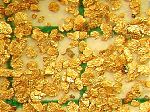 |
A short discription of the Rhinegold
The Rhinegold falls into the category “gold dust “ or “gold foil”. The gold foil is very small; at the upper Rhine they aren’t larger than 150/1000 millimeter. For 1 gram of gold you need about 280,000 foils.
Also some other minerals are bound in the Rhinegold; i.e. the melted Rhinegold contains: about 928/1000-parts of gold; about 63/1000-parts of silver and about 9/1000-parts of other minerals.
Size of Rhinegold grains sampled in the Upper Middle Rhine
A sieve analysis with the requested dimensions and 100 grs. of Rhinegold (sampled at several locations in the Upper Middle Rhine) showed the following results :
| between 0,40 and 0,35 mm | 0,05 grs. (= %) |
| between 0,35 und 0,25 mm | 0,60 grs (= %) |
| between 0,25 und 0,15 mm | 13,20 grs (= %) |
| between 0,15 und 0,09 mm | 36,40 grs (= %) |
| smaller than 0,09 mm | 49,75 grs (= %) |
How many Rhinegold grains are in one gram?
The answers found in the literature search strongly differ (from 20,000 up to 250,000). The number of grains depends on the sample region and the techniques and minerals used for extraction. Years ago there were hardly any techniques to extract the extremely fine powder gold in a range below 0.05 mm (except for amalgamation). Today the extraction of very fine natural gold is easily possible. Counting tests performed in 2004 with 100 grs. of Rhinegold of the Upper Middle Rhine (river kilometer 300 to 400) showed approx 282,000 grains per gram and thus an average grain weight of 0.0035 mg per grain. This result confirms the thesis introduced by Albiez in 1951, namely that washed gold of the Upper Middle Rhine is much smaller (grain weight of 0.003 to 0.005 mg) than described in literature.
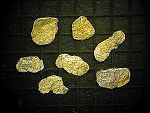 |
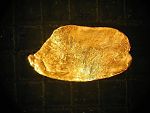 |
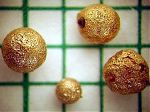 |
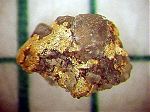 |
Fine gold content of melted Rhinegold
Several analyses led to the following results (which were all nearly similar; their mean value is shown here).
| Gold | 928,7 per mil=22,29 carat |
| Silver | 63,0 per mil |
| Other minerals | 8,3 per mil |
Wie viele Rheingoldflitter kommen auf 1 Gramm?
In der Literatur sind sehr unterschiedliche Angaben (von 20.000 bis 250.000) zu finden. Die Zahl wird beeinflusst aus welcher Region die Flitter stammen und mit welchen Techniken und Materialien sie gewonnen wurden. In früheren Jahren hatte man kaum Möglichkeiten, den sehr feinen Goldstaub im Bereich unter 0,05 mm (außer durch Amalgamierung) zu gewinnen. Die Gewinnung dieses sehr feinen Naturgoldes ist heute problemlos möglich. Meine Zählversuche im Jahr 2004 aus einer Menge von 100 Gramm Rheingold aus der Region „Mittlerer Oberrhein“ (ca. Stromkilometer 300 bis 400) brachte das Ergebnis von rd. 282.000 Flittern pro Gramm und damit ein durchschnittliches Gewicht pro Flitter von 0,0035 mg. Das Ergebnis bestätigt die von Albiez 1951 aufgestellte These, dass das Waschgold vom „Mittleren Oberrhein“ viel kleiner ist (Flittergewicht 0,003 bis 0,005 mg) als bis dahin in der Literatur dargestellt wurde.
Analysis of Rhine gold concentrate (Fa. Heraeus, 20.12.2007)
| Elements | unit | km 303 | km 360 | km 403 | |
| Aluminium | Al | ppm | 48 | 54 | 45 |
| Antimon | Sb | ppm | 61 | 54 | 35 |
| Arsen | As | ppm | 74 | 110 | 44 |
| Barium | Ba | ppm | 1 | <1 | <1 |
| Beryllium | Be | ppm | <1 | <1 | <1 |
| Blei | Pb | ppm | 20 | 16 | 15 |
| Bor | B | ppm | 2 | <1 | 1 |
| Cadmium | Cd | ppm | <1 | <1 | <1 |
| Cer | Ce | ppm | <1 | 3 | 1 |
| Chrom | Cr | ppm | <3 | <3 | <3 |
| Dysprosium | Dy | ppm | <1 | <1 | <1 |
| Eisen | Fe | ppm | 350 | 289 | 95 |
| Erbium | Er | ppm | <1 | <1 | <1 |
| Europium | Eu | ppm | <1 | <1 | <1 |
| Gadolinum | Gd | ppm | <1 | <1 | <1 |
| Gallium | Ga | ppm | <2 | <2 | <2 |
| Germanium | Ge | ppm | <1 | <1 | <1 |
| Holmium | Ho | ppm | <1 | <1 | <1 |
| Indium | In | ppm | <2 | <2 | <2 |
| Iridium | Ir | ppm | 7 | 2 | 1 |
| Kalium | K | ppm | <2 | <2 | <2 |
| Kalzium | Ca | ppm | 16 | 25 | 16 |
| Kobalt | Co | ppm | 2 | 3 | <1 |
| Kupfer | Cu | ppm | 357 | 298 | 263 |
| Lanthan | La | ppm | 2 | 3 | 2 |
| Lithium | Li | ppm | <1 | <1 | <1 |
| Lutetium | Lu | ppm | <1 | <1 | <1 |
| Magnesium | Mg | ppm | 8 | 10 | 6 |
| Mangan | Mn | ppm | 2 | 2 | 1 |
| Molybdän | Mo | ppm | <1 | <1 | <1 |
| Natrium | Na | ppm | <2 | <2 | <2 |
| Neodym | Nd | ppm | 1 | 3 | 2 |
| Nickel | Ni | ppm | 7 | 5 | 3 |
| Niob | Nb | ppm | <1 | <1 | <1 |
| Palladium | Pd | ppm | 82 | 56 | 37 |
| Phosphor | P | ppm | 4 | 6 | 4 |
| Platin | Pt | ppm | 1200 | 353 | 310 |
| Praseodym | Pr | ppm | <1 | <1 | <1 |
| Quecksilber | Hg | ppm | 912 | 889 | 554 |
| Rhenium | Re | ppm | <1 | <1 | <1 |
| Rhodium | Rh | ppm | 2 | <2 | <2 |
| Rubidium | Rb | ppm | <2 | <2 | <2 |
| Ruthenium | Ru | ppm | <4 | <4 | <4 |
| Samarium | Sm | ppm | <1 | <1 | <1 |
| Schwefel | S | ppm | 220 | 220 | 34 |
| Selen | Se | ppm | 13 | 10 | 6 |
| Silber | Ag | ppm | 6,83 | 6,1 | 4,73 |
| Silizium | Si | ppm | 131 | 124 | 119 |
| Strontium | Sr | ppm | <1 | <1 | <1 |
| Tantal | Ta | ppm | <1 | <1 | <1 |
| Tellur | Te | ppm | 4 | <2 | <2 |
| Terbium | Tb | ppm | <1 | <1 | <1 |
| Thorium | Th | ppm | 8 | 11 | <5 |
| Thulium | Tm | ppm | <1 | <1 | <1 |
| Titan | Ti | ppm | 2 | 2 | 2 |
| Uran | U | ppm | 120 | 80 | 7 |
| Vanadium | V | ppm | <1 | <1 | <1 |
| Wismut | Bi | ppm | <4 | <4 | <4 |
| Wolfram | W | ppm | 225 | 44 | 11 |
| Ytterbium | Yb | ppm | <1 | <1 | <1 |
| Yttrium | Y | ppm | 1 | 2 | <1 |
| Zink | Zn | ppm | 2 | 1 | <1 |
| Zinn | Sn | ppm | <2 | <2 | <2 |
| Zirkonium | Zr | ppm | <1 | <1 | <1 |
| sum (mg) | 3930 | 2726 | 1672 | ||
| Based on 1kg: | 1000 g | 1000 g | 1000 g | ||
| 63 elements | 3,93 g | 2,72 g | 1,67 g | ||
| Silver | 68,30 g | 61,00 g | 47,30 g | ||
| Gold | 927,77 g | 936,28 g | 951,03 g |

